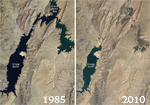Lake Mead, the massive reservoir that supplies water to millions of people across the southwestern U.S., has reached its lowest levels in nearly 75 years. Water levels dropped to 1,083 feet above sea level on Oct. 17, the lowest elevation since 1937, when the lake was first filled with the completion of the Hoover Dam. The dropping water level — which beats a previous record set in the 1950s — underscores the effects of drought and increased water demands on the Colorado River. “Everyone needs to know when we turn on the tap, it drains water out of the river and it has ecological consequences,” Gary Wockner, a campaign coordinator for the conservation group Save the Colorado, told the Arizona Republic. If water levels fall another eight feet, officials would have to implement water restrictions for Arizona and Nevada.
Drought Drops Lake Mead To Lowest Water Level Since 1937
More From E360
-
Climate
How Climate Risks Are Putting Home Insurance Out of Reach
-
INTERVIEW
Inside the Plastics Industry Playbook: Delay, Deny, and Distract
-
Biodiversity
Freeing Captive Bears from Armenia’s Backyards and Basements
-
Food & Agriculture
In Indonesia’s Rainforest, a Mega-Farm Project Is Plowing Ahead
-
FILM CONTEST WINNER
In the Yucatan, the High Cost of a Boom in Factory Hog Farms
-
INTERVIEW
In the Transition to Renewable Energy, China Is at a Crossroads
-
E360 Film Contest
In India, a Young Poacher Evolves into a Committed Conservationist
-
E360 Film Contest
The Amazon Rainforest Approaches a Point of No Return
-
Biodiversity
Shrinking Cod: How Humans Are Impacting the Evolution of Species
-
Cities
‘Sponge City’: Copenhagen Adapts to a Wetter Future
-
INTERVIEW
On Controlling Fire, New Lessons from a Deep Indigenous Past
-
Solutions
Paying the People: Liberia’s Novel Plan to Save Its Forests
